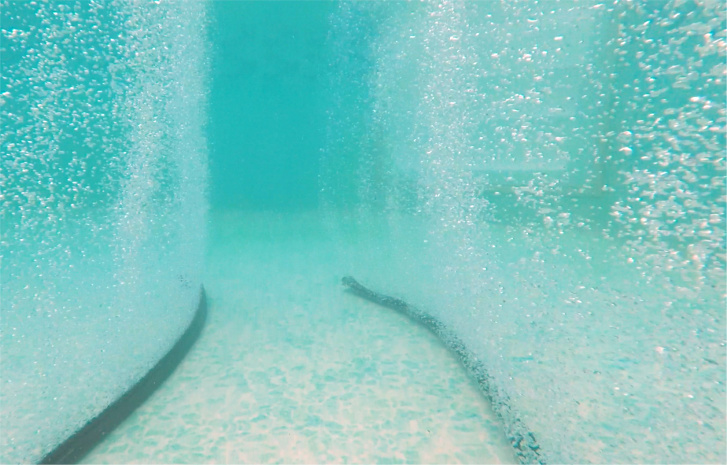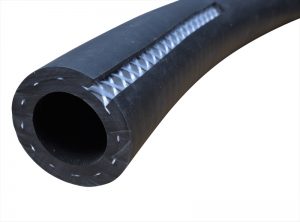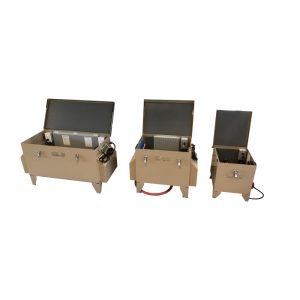Air Bubble Curtains
Air Bubble Curtains also known as Bubble Barriers
The bubble curtains created by the air released from our Bubble Tubing® have an enormous potential yet to be fully discovered and studied, with applications that could be used to protect swimmers and marine animals and environments.
Air Bubble Curtains are also known under several other names: Air barrier, air curtain, bubble barrier, bubble curtain, pneumatic barrier, pneumatic boom, barrier of air bubbles, curtain of air bubbles, air bubble curtains, bubble wall, bubble screen.
How do Bubble Curtains function?
The interest in bubble curtains and the effect of air bubbles in water was studied in detail during the Second World War to block sound waves created by submarines. The rate of sound wave dispersion and the propagation of energy densities that would typically be observed have been demonstrated to be reduced by underwater air bubble curtains. The effectiveness of bubble curtains depends mainly on the frequency of the waves, the volume of air injected, the size of the bubbles, the number of air diffuser lines used and the distance between the bubbles emanating from the air diffuser lines.
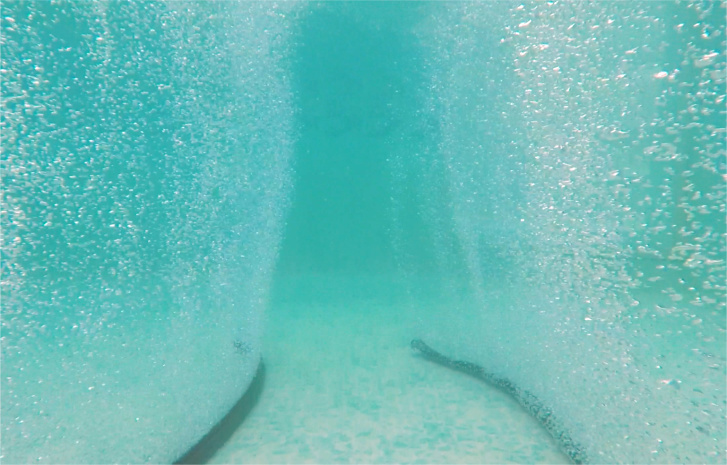
The operating principle of a curtain of bubbles consists of creating a more or less dense wall, a flexible bubble barrier that rises continuously from the bottom of the water to the surface.
This wall of air bubbles is created using a suitably adapted compressor and capable of operating continuously according to the estimated air volume. These bubble curtains serve as a buffer zone to reduce the impact of frequent shock- and soundwaves dispersing in the water from a specific source (e.g. seabed pile driving). The injected air flow must be sufficient to form a very dense and efficient bubble curtain. Depending on the project, we regularly suggest the installation of double or triple bubble curtains to maximise the number of bubbles present. In the case of a double or triple curtain, the lines of Bubble Tubing® diffusers are installed parallel to one another at a distance unique to each project. The reasoning is that each layer of bubble tubing contributes to the reduction of the total impact, so by incorporating several layers it is possible to increase protection in the aquatic environment.
Independent studies are underway to determine the specific capacity of Bubble Tubing®. The market for noise attenuation and environmental protection by two-phase barriers is indeed evolving.
What are the various functions of Bubble Curtains?
Mitigate damage in marine environments from the noise and the effect of blasting due to mining, drilling, seismic surveys and underwater pile driving.
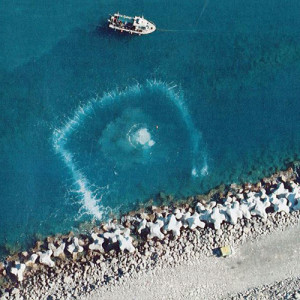
Bubble barriers act as a sound attenuation system as they reduce the effects of shock waves from underwater explosions. Weighted Bubble Tubing installed on the sea floor in a marine application attenuates the propagation of sound waves and the effect of undersea blast shock and pile driving that can harm marine life. The applications for bubble curtains are numerous.
Marine pile driving at large construction sites produces considerable noise and high pressure underwater. These conditions can be lethal to fish and can harm marine mammals. To reduce sub-aquatic sounds generated by work sites, projects now employ air bubble curtains. These air bubble curtains provide an effective barrier to sound propagating through water, because of the difference in density between air and water.
Multiple lines of air bubble curtains can increase the efficiency of the attenuating effects of the bubbles. A series of Bubble Tubing® rings around the pile generates denser bubble curtains. Bubble Curtains are a potential strategy as a mitigation measure to address acoustic impacts to marine mammals in the new NOAA Ocean Noise Strategy Roadmap.
Common sources of high-pressure noise at sea:
- Demining operations and underwater blasting
- Seismic surveys
- Pile driving
- Drilling for the installation of offshore wind turbines
- Retraction of marine structures
- Oil prospecting activities (seismic)
- Military activity using seismic or sonar equipment
- Port and coastal development

Protecting marine mammals from offshore oil platforms and wind power farm construction and continuous operation vibrations and noise (machinery and engine noise)
Offshore drilling and oil exploration in maritime environments and their effect on the ecosystem are of great concern. Noise mitigation technology to reduce underwater sound coming from marine construction, oil exploration, as well as continuous noise coming from offshore oil extraction and wind power companies operations are required.
In the ocean, whales and other marine mammals use gentle sound pulses to communicate about feeding, mating, and to keep their groups together. But as we increasingly probe the ocean, the loud sounds of exploration, development, and construction send powerful waves that can confuse, disorient and harm these marine mammals.
Reducing underwater sounds is an important goal. Air bubble curtains offer a promising means of lessening the impact of aggressive sound on marine mammals by confining and reducing the sound intensity and the speed over which the sound waves travel.
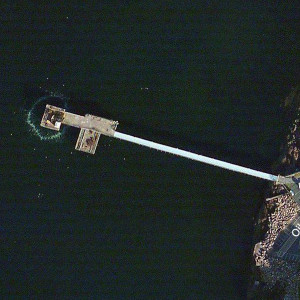 Surrounding ongoing undersea operations with walls of bubbles will alter the shape of the noise waves. When a pressure wave hits an air bubble, it will compress the bubble, and then it will expand again, so energy is lost. Sound travels faster through water than air but will slow down if it hits air bubbles.
Surrounding ongoing undersea operations with walls of bubbles will alter the shape of the noise waves. When a pressure wave hits an air bubble, it will compress the bubble, and then it will expand again, so energy is lost. Sound travels faster through water than air but will slow down if it hits air bubbles.
A continuous sound or an impulsive sound greater than 160 decibels could disturb the behaviour of marine mammals. Even constant noise, coming from oil exploration and extraction is different from the staccato bursts emitted by driving piles, engines and machinery on board ships.
Air bubbles are then a means of reducing the sound transmitted from stationary sources. By surrounding a rig or ship with bubbles of air, the amount of noise can be reduced and dispersed.
Containing oil spills within a given area
Another primary concern over offshore drilling and oil exploration is in oil spill containment. Oil spills related to maritime and inland waterway transport is also a risk.
Air Bubble curtains can act as a containment measure in the case of an oil spill in calm waters, e.g. for protecting harbours, marinas or seaports and shorelines.

Compressed air released from a submerged, perforated tubing creates a bubble air barrier. The resulting rising curtain of bubbles produces an up-swelling on the water surface above the tubing. Trapped behind the raised surface formed by this up-swelling are the floating oil molecules. The air barrier (air curtain) represents an alternate method of containing or confining spilt oils within a given area, allowing time for implantation of decontamination methods.
Fish guiding and containment systems in waterways such as rivers
There is an increasing demand for marine life conservation worldwide. Submerged air bubble curtains not only reduce the sound but create a linear screen that can protect, deflect, herd & guide particular fish species away from the pile, water intakes, hydroelectric dams or contaminated areas.
In Denmark, RS Coast Care has tested Air Bubble Curtains with our Bubble Tubing® to protect beaches, harbours and coastlines against seaweed, algae, jellyfish and other floating debris.
More and more companies are specializing in the development of barrier protection systems for small fish such as salmon smolts that migrate between rivers and the sea.
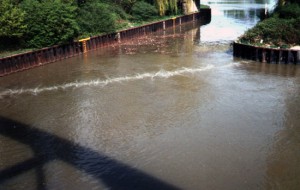
These companies contact us to obtain our Bubble Tubing® to integrate into their existing guiding systems that function with various components. Bubble Tubing® creates a bubble curtain deterring fish from swimming past the bubble wall. By installing Bubble Tubing® in a strategic location of a dam, a hydrant or other engineering structure, we can redirect fish to ladders specially designed for them. Other components such as strobe lights and sounds at low frequencies can be added to redirect the fish to safe places or prevent them from passing into water intakes that can be fatal to the fish.
As seen in the video below, air bubble curtains made of Bubble Tubing® are already in use as fish screening systems to stop jellyfish from entering and blocking water intake pipes in the United Kingdom.
- See how our Bubble Tubing® can control the movement of jellyfish on our customer Coastwork YouTube channel.
- See how our Air Bubble Curtains can control the movement of debris, sediments, etc. on our YouTube channel.
Motion control and direction of floating debris
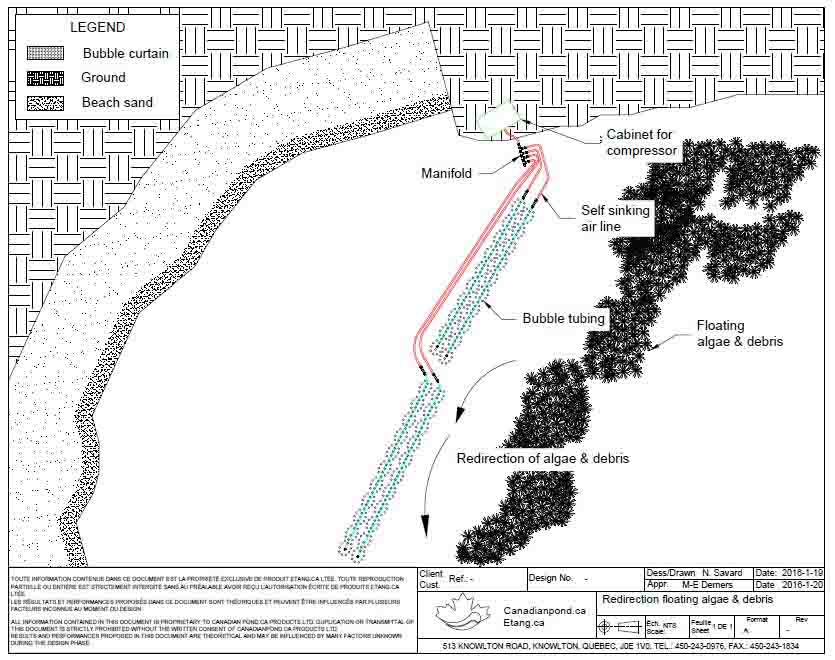 A growing problem for motel chains and other tourism businesses living along coastal regions is a seaweed called Sargassum. This seaweed is pushed by waves on the beaches and can sometimes accumulate up to 3 meters thick! The daily costs associated with the machinery and the quantity of employees required for to the collection of these seaweeds is staggering. The growing presence of Sargassum (and indeed many other species of aquatic plants or algae) in the sea is due to the increased presence of nutrients in the water as well as to temperature, sea currents and winds changes. The tourism industry is affected by this problem in areas such as the island of Saint-Martin, Guadeloupe, Mexico and Martinique. Other debris may be found floating on the water surface such as bottles, plastic bags and microplastics. Installing bubble curtains can be a solution to contain these floating debris and algae for easier retrieval before they arrive on the coasts. Bubble curtains can prevent floating debris from entering channels or create a current that can repel algae and debris to a less sensitive area.
A growing problem for motel chains and other tourism businesses living along coastal regions is a seaweed called Sargassum. This seaweed is pushed by waves on the beaches and can sometimes accumulate up to 3 meters thick! The daily costs associated with the machinery and the quantity of employees required for to the collection of these seaweeds is staggering. The growing presence of Sargassum (and indeed many other species of aquatic plants or algae) in the sea is due to the increased presence of nutrients in the water as well as to temperature, sea currents and winds changes. The tourism industry is affected by this problem in areas such as the island of Saint-Martin, Guadeloupe, Mexico and Martinique. Other debris may be found floating on the water surface such as bottles, plastic bags and microplastics. Installing bubble curtains can be a solution to contain these floating debris and algae for easier retrieval before they arrive on the coasts. Bubble curtains can prevent floating debris from entering channels or create a current that can repel algae and debris to a less sensitive area.
Silt Barrier and turbidity curtains to contain sediments in suspension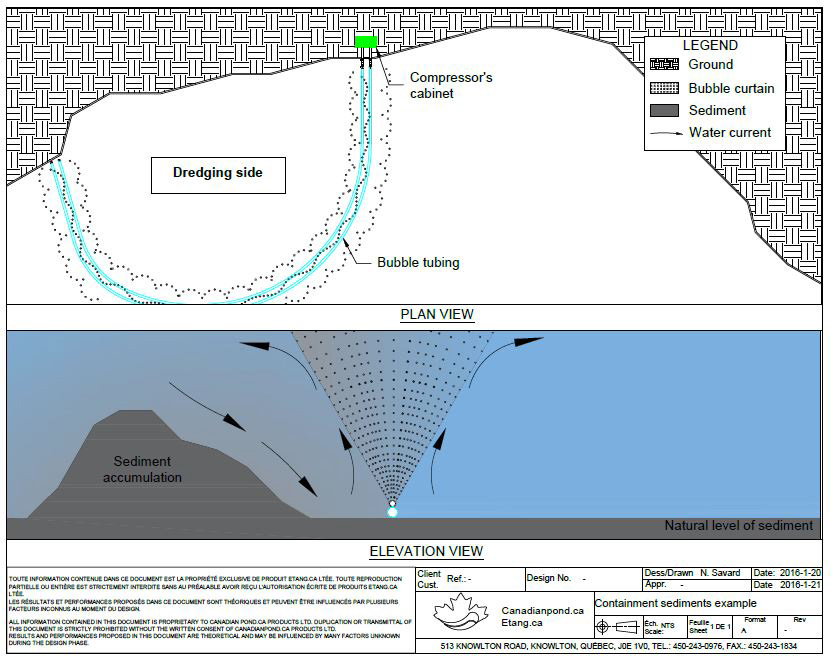
Bubble curtains also meet the requirement for containing silt and turbidity for in-situ work where sediment containment barriers are mandatory. When operating in a stream, river or lake, marine construction and dredging companies are required to install a physical curtain called a floating turbidity barrier.
These obstacles do not allow free passage for boats and work equipment. Whereas a bubble curtain does both: it allows movement of boats and equipment over the barrier while retaining sediment and other suspended matter. In this case, a bubble curtain installed from the stream, river or lake bed will mitigate the migration of silt and other suspended sediments through the water column.
Our Bubble Tubing® has proven to be very useful as a silt barrier and turbidity curtain during these applications. Also, in this article, research is currently underway to validate the effectiveness of bubble curtains in altering stream dynamics. Water currents in the outer curves of riverbeds are slower allowing for sediment deposition and accumulation. Over time, a sand bank can be created, making shipping impossible without dredging under certain circumstances. By installing a bubble curtain in this outer curve, this creates a sufficient current to prevent sediment buildup.
These are a few of the applications for Bubble Curtains. We look forward to working closely with engineers, scientists and water managers to find bubble curtain applications to protect wildlife and the environment so projects can move forward in an environmentally responsible manner.
Who may need to create a bubble barrier?
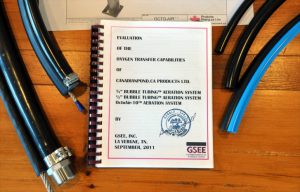
Demand for bubble curtains is booming. Who are our customers:
- Port authorities
- Shipbuilding companies
- Acoustic reduction specialists
- Environmental firms
- Hotel chains
- Oil platform managers
- Companies specialising in dredging
- Marine construction companies
- Hydroelectric dam managers
- Companies specialising in fish barriers
- Naval bases
- Environmental engineering firms
- Cities to recover waste in canals and rivers
- Floating waste recovery companies
- Environmental groups and citizen associations
